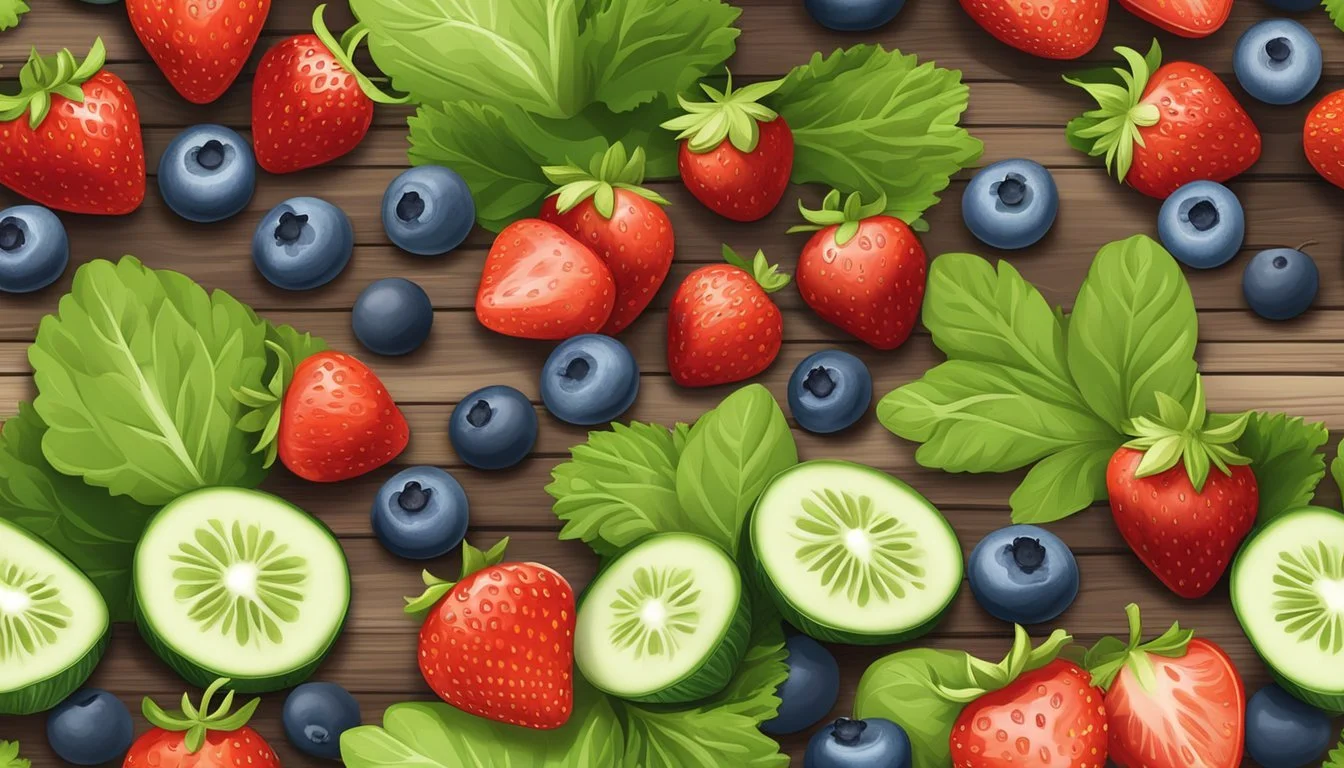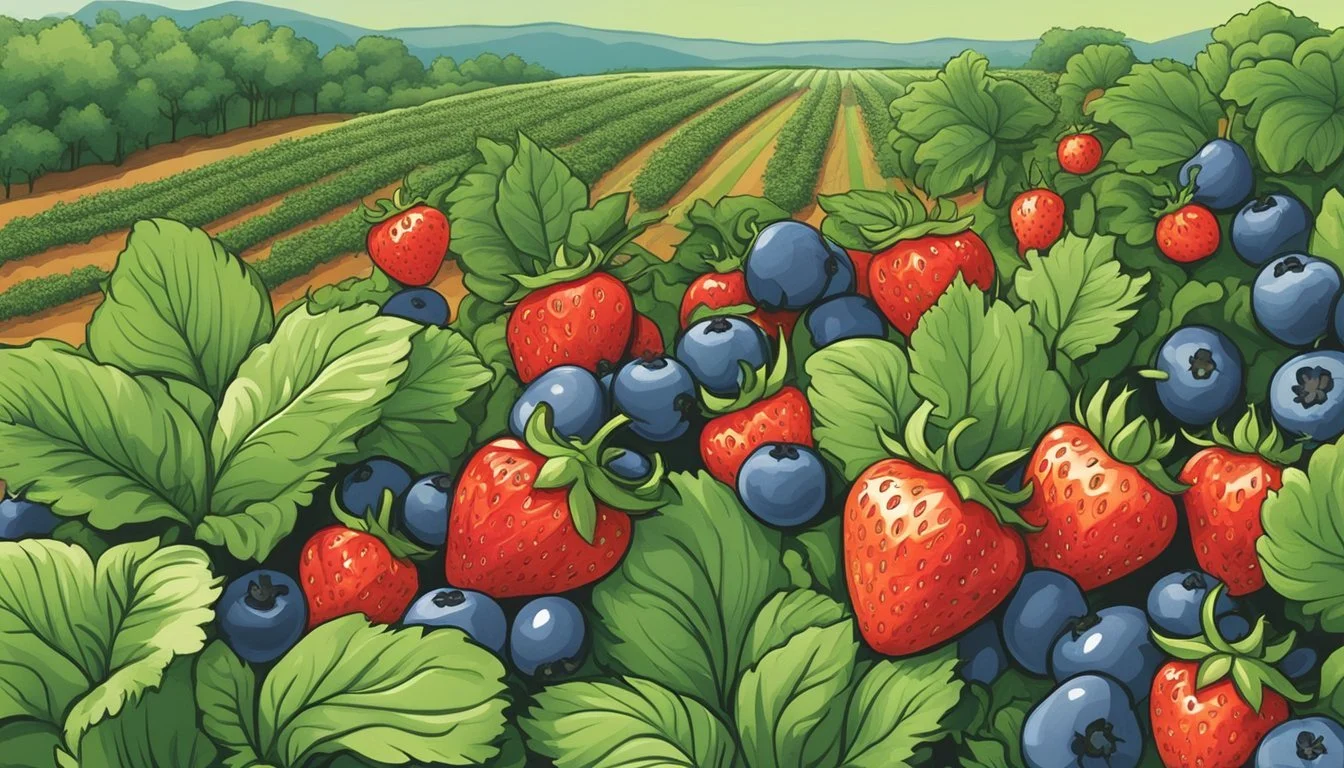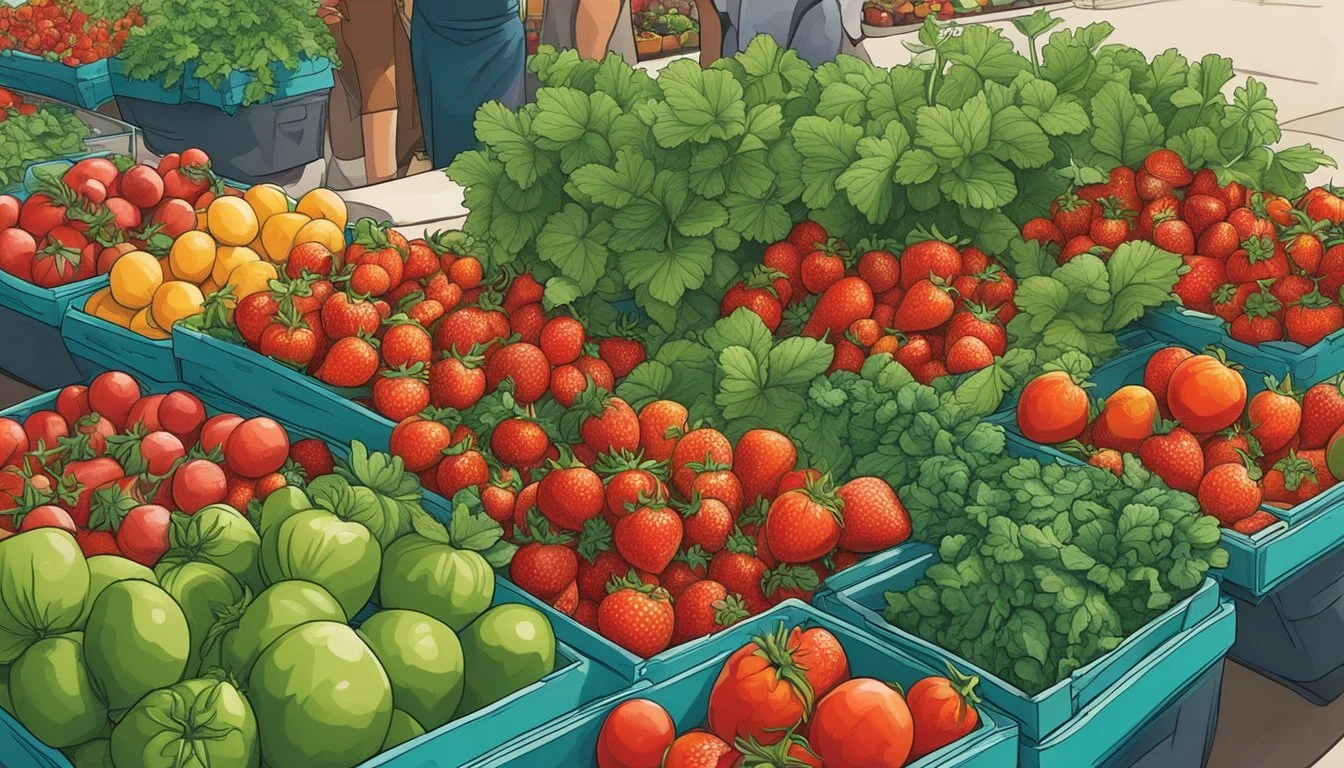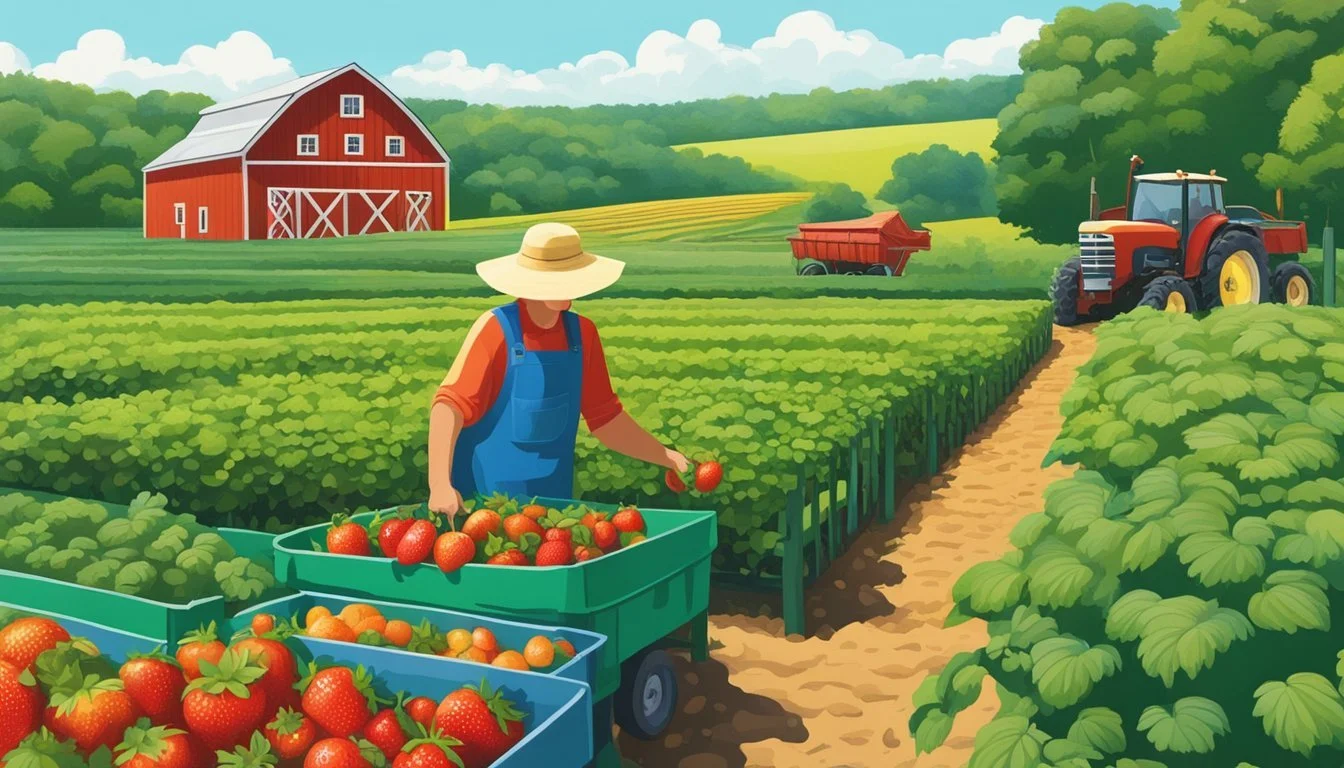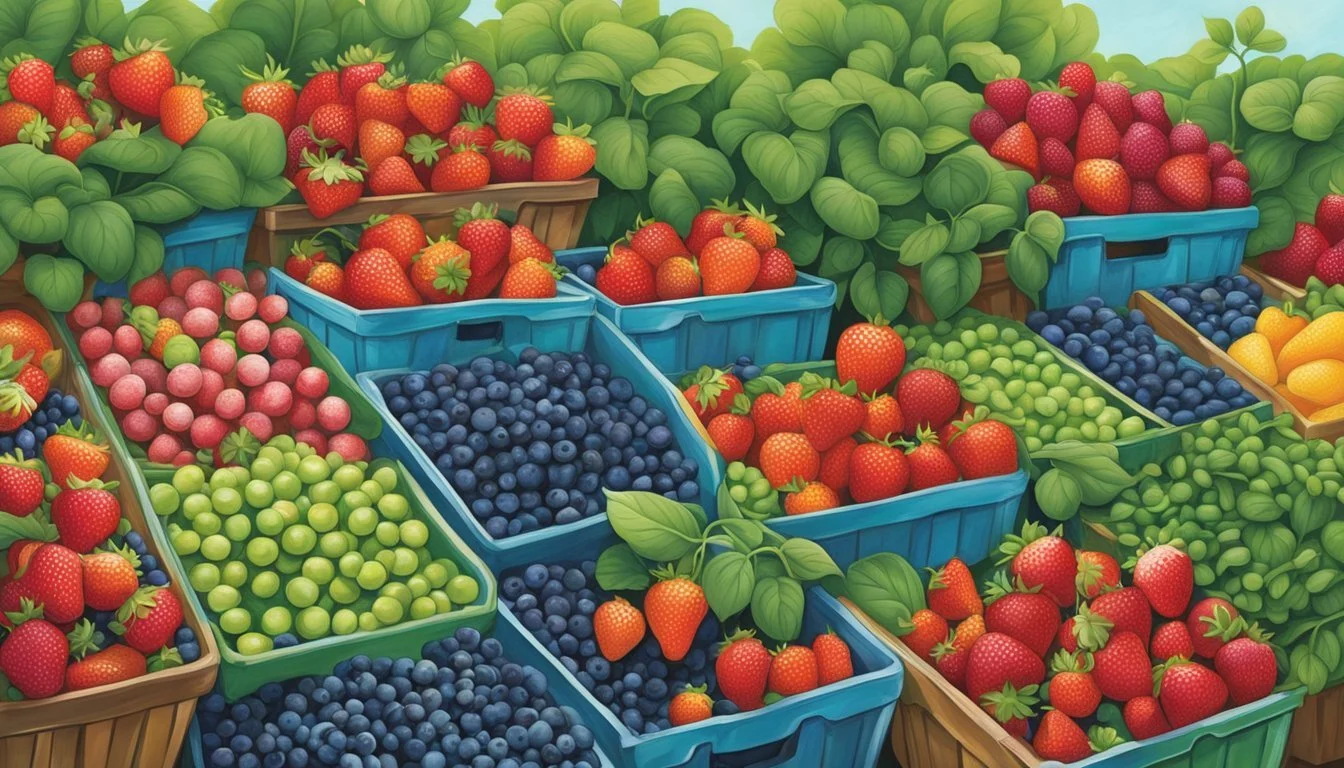Rhode Island Seasonal Fruit & Vegetables in June
Your Fresh Guide
This Article is Part of our Rhode Island Seasonal Fruit & Veg Calendar
June in Rhode Island marks the arrival of a diverse array of fresh fruits and vegetables. As summer begins, farmers' markets and local gardens come to life with vibrant produce. This period is ideal for indulging in the freshest seasonal offerings, which not only promise the peak of flavor but also support sustainable agricultural practices within the state.
This time of year, Rhode Island’s climate creates the perfect growing conditions for various fruits and vegetables. Shoppers can expect to find a bounty of produce including leafy greens like arugula and chard, crisp vegetables like snap peas and cucumbers, and the beginning harvests of sweet berries. The abundance is not only a cook’s delight but also an opportunity for anyone to explore and connect with the local food scene.
The focus on seasonal eating aligns with Rhode Island's rich agricultural tradition, fostering a unique regional cuisine. This cuisine is characterized by high-quality, locally-sourced ingredients that reflect both the state's heritage and its adaptability to seasonal changes. In June, these ingredients are at their freshest, allowing for a culinary experience that's deeply rooted in the local environment and its rhythms.
Overview of Rhode Island's Seasonal Produce
In June, Rhode Island's local farms flourish with an array of fresh produce that is both vibrant and rich in flavor. Seasonal fruits such as strawberries become ripe and ready for harvest, providing a sweet treat for those eager to enjoy the natural bounty. Blueberries also start to make an appearance towards the latter part of the month, signaling the start of berry season.
Vegetables thrive during this time as well, with leafy greens like lettuce and spinach (What wine goes well with spinach?) being harvested in abundance. These greens complement a variety of dishes and are prime for farm-to-table experiences. Other vegetables coming into season include beets (how long do beets last?), which are versatile for both culinary uses and nutritional benefits.
Rhode Island's farmers' markets become bustling centers of activity as the local population seeks out the freshest, locally sourced products. These markets support the direct relationship between farmers and consumers, ensuring that the local economy benefits from the cycle of seasonal harvests.
In Season Produce Harvest Period Availability at Farmers' Markets Strawberries Early June Widespread Blueberries Late June Starting to Appear Lettuce June Widespread Spinach June Widespread Beets June Common
Rhode Island's climate and geography contribute to the unique growing conditions that define the character of its produce. With the commitment to sustainability and freshness, consumers relish in the flavors that are as rich as the land from which they came. Thus, the month of June offers a gem of opportunities for those looking to indulge in seasonal, local produce.
Advantages of Consuming Local Produce
In Rhode Island, the choice to consume local produce in June brings with it a variety of benefits, addressing both personal health and environmental sustainability. Local produce is often fresher, having been harvested at peak ripeness. This not only enhances the flavor but also the nutritional value, ensuring consumers enjoy the full spectrum of vitamins and minerals that fruits and vegetables should offer.
Health and Flavor
Freshness: The shorter the time between the farm and the table, the less likely it is that nutrients will be lost. Local fruits and vegetables can be consumed shortly after harvesting, which preserves their freshness and maximizes their taste.
Variety: Local farms are more likely to grow a wider range of varieties that are better tasting and more nutritious rather than being bred for long shelf life.
Economic Benefits
Supporting Local Economy: When consumers buy local, they contribute to the sustainability of local farms and the local economy, encouraging the growth of local agribusiness.
Environmental Impact
Sustainability: Local produce requires less transportation, thereby reducing carbon emissions and helping to protect the environment. This aspect of local consumption not only benefits the climate but also ensures the produce is less exposed to unnecessary handling and contaminants.
Seasonality: Understanding and embracing seasonality leads to a natural diversity in diet. Cooking with the seasons in mind promotes creativity in the kitchen and allows consumers to experience flavors at their prime.
In summary, consuming local produce from Rhode Island's rich selection of fruits and vegetables in June offers consumers improved taste and nutritional benefits, boosts the local economy, and fosters a more sustainable environment.
Fruit Highlights in June
June is a peak season for a variety of fruits in Rhode Island. This month introduces an abundant harvest of berries and the beginning of stone fruit season, offering a fresh palette of flavors.
Berries
Strawberries: June is prime time for strawberries in Rhode Island, with farms bustling for the pick-your-own season.
Blueberries: Towards the end of June, blueberries start to make an appearance, heralding their impending peak season.
Blackberries and Raspberries: While they may start a bit later in the summer, some early varieties can be found in June.
Stone Fruits
Cherries (how long do cherries last?): Sweet and tart cherries become ripe for picking, marking their brief but beloved season.
Apricots: These tender fruits start to reach ripeness in June, though they hit their stride later in the summer.
Peaches: Early varieties of peaches begin to show up in markets, with their juicy sweetness just starting to flourish.
Other Early Summer Fruits
Rhubarb: Although not a fruit by botanical standards, rhubarb is commonly paired with fruits in dishes and is typically still available from earlier months.
Tropical and Exotic Varieties
Rhode Island's climate does not support the local growth of tropical and exotic fruits; most are imported during this time.
Vegetable Highlights in June
June in Rhode Island brings a harvest brimming with a variety of vegetables, painting local markets with vibrant greens and an array of colors. Chefs and home cooks alike revel in the peak season freshness, incorporating these ingredients into seasonal dishes that showcase their flavors.
Leafy Greens
In June, Rhode Island's leafy greens are at their peak. Lettuce, spinach, collards, kale, and chard flourish in the cooler parts of the month, offering a bounty for salads and cooked dishes. They provide versatility in cooking, whether one opts for a crisp Caesar salad or sautéed greens as a nutritious side.
Root Vegetables
Root vegetables such as beets, carrots, and radishes make their mark in June. These vegetables can be enjoyed raw, adding a crunchy texture and earthy flavors (What wine goes well with earthy flavors?) to dishes, or they can be roasted to bring out their natural sweetness.
Beets: Rich in color and flavor, perfect for roasting or pickling.
Carrots: Ideal for snacking, salads, or adding sweetness to cooked dishes.
Radishes: Excellent when used to add a peppery bite to salads.
Summer Staples
Tomatoes, cucumbers, peppers, zucchini (What wine goes well with zucchini?), and eggplant start to enter the market in June. These staples embody the essence of summer cooking in Rhode Island. They are popular for grilling, stuffing, or making into refreshing salads. Home gardens and farmers' markets become hubs for these summer favorites.
Tomatoes: Juicy and ripe, a key ingredient for salsas and salads.
Cucumbers: Refreshing and crisp, ideal for salads and cooling sides.
Peppers: Range from sweet to spicy, great for adding depth to dishes.
Zucchini & Eggplant: Versatile for baking, grilling, or frying.
Herbal Additions
Herbs like basil, cilantro, dill (how long does dill last?), and parsley come into full swing in June. These aromatic additions complement the flavors of both the leafy greens and root vegetables and can elevate the simplest dishes with their fresh, bold tastes. They are essential for seasoning, garnishes, or making pesto and sauces.
Basil: Sweet and aromatic, perfect for pesto and pairing with tomatoes.
Cilantro: Offers a lemony, tangy flavor to salads and salsas.
Dill: Feathery and light, pairs well with fish and summer salads.
Parsley: Bright and clean, a universal garnish for a fresh finish.
Seasonal Availability and Timing
June in Rhode Island marks the transition from spring to summer, bringing a diverse availability of fresh produce. As spring crops peak, summer fruits and vegetables start to come into season.
Fruits: Early June sees the tail end of the spring fruit harvest, such as strawberries that began ripening typically by late May. By mid-June, blueberries start to become available, providing a sweet and nutritious option for consumers.
Vegetables: Vegetables are abundant with several varieties reaching their prime. Leafy greens like spinach and lettuce have been available since March and continue through June. Root vegetables such as beets and carrots, planted as early as April, are now ready to be enjoyed. In addition, the warm early summer weather allows for the harvesting of cucumbers and summer squash.
Here's a brief summary of when key produce items are generally available:
Produce Type Availability Strawberries May - Early June Blueberries Mid-June - August Spinach March - June Lettuce March - June Beets June - September Carrots June - November Cucumbers June - September Summer squash June - September
Bear in mind this information is approximate as harvesting times can vary based on factors like weather and specific varietal differences. It is always advisable for consumers to check with local farms for the most current crop statuses. June, however, is a reliable month for a bounty of both the last cool-weather crops and the beginning of warm-weather favorites.
Preparing and Cooking Seasonal Foods
June in Rhode Island brings a bounty of fresh vegetables and fruits that are just ripe for cooking. Preparing these seasonal foods allows one to enjoy the fullest flavors while supporting local agriculture.
Vegetables: They should start by washing all vegetables thoroughly. Items like leafy greens benefit from a gentle rinse, while firmer vegetables like radishes and beetroots might need a soft scrub. Simple cooking methods bring out the natural taste of the vegetables. Steaming is ideal for keeping their nutritional value intact, while grilling can impart a smoky flavor that's perfect for the early summer.
Fruits: Fruits harvested in June such as strawberries and cherries are often best enjoyed fresh to savor their natural sweetness. However, they can also be incorporated into various recipes. One might consider making a refreshing fruit salad or a rustic tart that celebrates the essence of these seasonal delights.
Herbs: The addition of fresh herbs can transform a dish with their vibrant flavors. Herbs such as basil, parsley, and cilantro should be used fresh and added towards the end of the cooking process to preserve their delicate taste.
When cooking these seasonal ingredients, it’s important to remember that less is more. A light hand in seasoning allows the natural flavors of the fruits, vegetables, and herbs to be the heroes of the dish.
Seasonal Ingredients Preparation Suggestions Leafy Greens Rinse and serve in salads or lightly sauté Radishes Wash and slice for a crisp addition to dishes Beetroots Scrub and roast to enhance their earthy flavor Strawberries Hull and serve fresh or use in desserts Cherries Pit and enjoy raw or bake into clafoutis Herbs Chop and sprinkle over dishes to finish
The key to cooking with June’s seasonal produce in Rhode Island is to let the quality of the fresh ingredients shine, pairing them with simple techniques and complementary herbs to enhance their natural flavors.
Where to Find Seasonal Foods in Rhode Island
Rhode Island offers a variety of locations where consumers can find fresh, seasonal produce in June, ranging from farmers markets and pick-your-own farms to local grocers and specialty stores.
Farmers Markets
Local Farmers Markets are abundant in Rhode Island, and they typically run on specific days of the week. Shoppers can find a variety of seasonal fruits and vegetables, often including organic and locally grown options. For example:
South Kingstown Farmers Market operates on Saturdays from 9 am to 12:30 pm at Independence Square.
Block Island Summer Farmers Market, open Fridays from 2 pm to 6 pm, is another option where local seasonal produce is available.
Pick-Your-Own Farms
Pick-Your-Own Farms provide a hands-on experience for those looking to harvest their own fruits and vegetables directly from the farm. Availability may depend on crop conditions and weather, so it's advisable to check with each farm before visiting.
Elwood Orchard: Offers a variety of pick-your-own options in June which may include strawberries and other seasonal fruits.
Rocky Point Farm in Warwick: Known for strawberry picking in the state, the farm welcomes visitors during the season.
Local Grocers and Specialty Stores
Local Grocers and Specialty Stores in Rhode Island also stock seasonal produce sourced from the surrounding areas. These stores may have a stronger emphasis on:
Supporting local farmers by offering Rhode Island-grown produce.
Providing a curated selection of seasonal goods that may not be available at larger chain stores.
Most local stores will have a map or a guide indicating the source of their produce, ensuring consumers are aware of the local aspect of their purchase.
Sustainable Practices and Environmental Impact
In June, Rhode Island farms prioritize sustainability in their cultivation of seasonal fruits and vegetables. By employing varying Good Agricultural Practices (GAP), Rhode Island farmers aim to minimize their environmental impact. One of the keystones of these practices is to reduce foodborne illnesses, ensuring the well-being of both the local communities and environment.
Local growers integrate sustainable practices, like crop rotation and organic farming, to maintain soil health and reduce the need for chemical fertilizers. For instance, use of natural compost enhances soil nutrition, fostering an optimal growing environment.
Here are some sustainable strategies that Rhode Island farms might use in June:
Integrated Pest Management (IPM): Combating pests with minimal ecological disruption.
Conservation Tillage: Reducing soil erosion and preserving soil structure.
Rainwater Harvesting: Utilizing rainwater for irrigation, reducing reliance on the local water supply.
Cover Cropping: Protecting the soil and managing weeds and pests in an eco-friendly way.
Local farms strive not only to deliver fresh, seasonal produce but also to conserve the surrounding natural resources. By focusing on local market demands, these farms help reduce the carbon footprint associated with long-distance transport of foods.
Through education and support from initiatives like URI Cooperative Extension, farmers are equipped with the most current sustainability knowledge. Workshops and on-farm training sessions are examples of efforts to bolster the local food systems’ resilience and reduce environmental impact.
Engaging with Rhode Island's Farming Community
June in Rhode Island ushers in a lush bounty of seasonal fruits and vegetables. The farming community is the backbone of this abundance, with local farmers diligently tending their crops. Community Supported Agriculture (CSA) programs, like the one operated by Casey Farm, offer individuals a direct way to engage with these farmers. Through CSA shares, typically running twenty weeks from mid-June, community members receive a selection of fresh, organic produce, supporting both their health and local agriculture.
Hope's Harvest represents another facet of community engagement, where volunteers gather to collect surplus from local farms. This surplus produce is then channeled to hunger relief agencies, creating a bridge between the abundance of the land and the needs of the community.
Engagement can also be educational. The University of Rhode Island's Cooperative Extension equips local growers with sustainable and profitable crop production practices. Opportunities for learning include newsletters and on-farm workshops, fostering an environment of continuous improvement for farmers and enthusiasts alike.
The Senior Farmers Market Nutrition Program (SFMNP) in Rhode Island complements these efforts by providing elderly residents with produce boxes. These boxes contain a range of vegetables, fruits, and herbs and contribute to the engagement between the local farming community and diverse demographic groups.
In summary, engaging with Rhode Island's farming community in June is multifaceted. It involves:
Participating in CSA programs for fresh produce.
Volunteering with organizations like Hope's Harvest to distribute food.
Learning through initiatives by educational institutions.
Supporting senior nutrition through state programs.
All these avenues strengthen the bonds between farmers, the local community, and the diverse populations they serve.
Conclusion
Rhode Island's June produce landscape is notable for its diversity and freshness. Growers and consumers alike look forward to this month, as it marks the availability of an array of fruits and vegetables. They can find joy in the peak harvest of strawberries and the beginnings of raspberry and blueberry seasons.
Fruits:
Strawberries: Peak season
Raspberries: Starting
Blueberries: Beginning to ripen
Vegetables flourish under the nurturing sun of June. Salad greens, such as lettuce and spinach from greenhouses, continue to provide freshness on the table. Meanwhile, outdoor crops like peas and zucchini start to take their place at local markets. Rhubarb, often grouped with fruits, is still being harvested, perfect for pies and jams.
Lettuce: Continued harvest
Spinach: Available
Peas: Emerging in market
Zucchini: New arrivals
Rhubarb: Available
This information is vital for consumers aiming to eat seasonally and locally. It guides purchases at farmers' markets and aids in supporting the local agricultural economy. It also indicates prime picking times for those looking to harvest their own fruits and vegetables.
Farmers advise verifying the exact dates for harvest readiness, as they may fluctuate due to seasonal weather changes. They encourage patrons to visit farms or contact them to experience the freshest produce. One should always remember, availability may vary by specific regions within the state.

